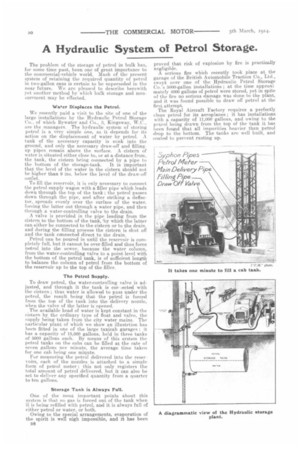A Hydraulic System of Petrol Storage.
Page 20

If you've noticed an error in this article please click here to report it so we can fix it.
The problem of the storage of petrol in bulk has, for some time past, been one of great importance to the commercial-vehicle world. Much of the present system of retaining the required quantity of petrol in two-gallon cans is certain to be superseded in the near future. We are pleased to describe herewith yet another method by which bulk storage and measurement may be effected.
Wafer Displaces the Petrol.
We recently paid a. visit to the site of one of the large installations by the Hydraulic Petrol Storage Co., of which Bywater and Co., 3, Kingsway, W.C., are the managers. The hydraulic system or storing petrol is a very simple one, as it depends for its action on the displacement of water by petrol. A tank of the necessary capacity is sunk into the ground, and only the necessary draw-off and filling up pipes remain above the surface.. A cistern of water is situated either cloSe, to, or at a distance from, the tank, the cistern being connected by a pipe to the bottom of the storage-tank. It is important that the level of the. water in the cistern should not be higher than 9 ins, below the level of the draw-off outlet.
To fill the reservoir, it is only necessary to connect the petrol supply wagon with a filler pipe which leads down through the top of the tank ; the petrol passes down through the pipe, and after striking a deflector,.spreads evenly over the surface of the water. forcing the latter out through a water pipe, and then through a water-controlling valve to the drain. A valve is provided in the pipe leading from the cistern to the bottom of the tank, 'by which the latter can either be connected to the cistern or to the drain. and during the filling process the cistern is shut off and the tank cdnnected direct to the drain.
Petrol can be poured in until the reservoir is completely full, but it cannot be over-filled and thus force petrol into the sewer, because the water column, from the water-controlling valve to a point level with the bottom of the petrol tank, is of sufficient length to balance the column of petrol from the bottom of the reservoir up to the top of the filler.
The Petrol Supply.
To draw petrol, the water-controlling valve is adjusted, and through it the tank is con.lected with the cistern ; thus water is allowed to pass under the petrol, the result being that the •petrol is forced from the top of the tank into the delivery nozzle, when the valve of the latter is opened. The available head of water is kept constant in the cistern by the ordinary type of float and valve, the supply being taken from the city water mains. The nartieill,9,r plant of which we show an illustrtion has been fitted in one of the large taxicab garages: it has a capacity of 15,000 gallons, held in three tanks of 5000 gallons each. By means of this system the petrol tanks on the cabs can be filled at the rate of seven gallons Der minute, the average time taken for one cab being one minute.
For measuring the petrol delivered into the reservoirs, each of the nozzles is attached to a simple form of petrol meter ; this not only registers the total amount of petrol delivered, but it can also be set to deliver any specified quantity from a quarter to ten gallons.
Storage Tank is Always Full.
One of the most important points about this system is that no gas is forced out of the tank when it is being refilled with petrol, and it is always full of either petrol or water, or both.
Owing to the special arrangements, evaporation of the spirit is well nigh impossible, and it has been D8 proved that risk of explosion by fire is practically negligible.
A serious fire which recently took place at the garage of the British Automobile Traction Co., Ltd., swept over one of the Hydraulic Petrol Storage Co.'s 5000-gallon installations ; at the time approxi mately 4000 gallons of petrol were stored, yet in spite of the fire no serious damage was done to the plant, and it was found possible to draw off petrol at the first attempt.
The Royal Aircraft Factory requires a perfectly clean petrol for its aeroplanes ; it has installations with a capacity of 11,000 gallons, and owing to the petrol being drawn from the top of the tank it has been found that all impurities heavier than petrol drop to the bottom. The tanks are well built, and coated to prevent rusting up.


























